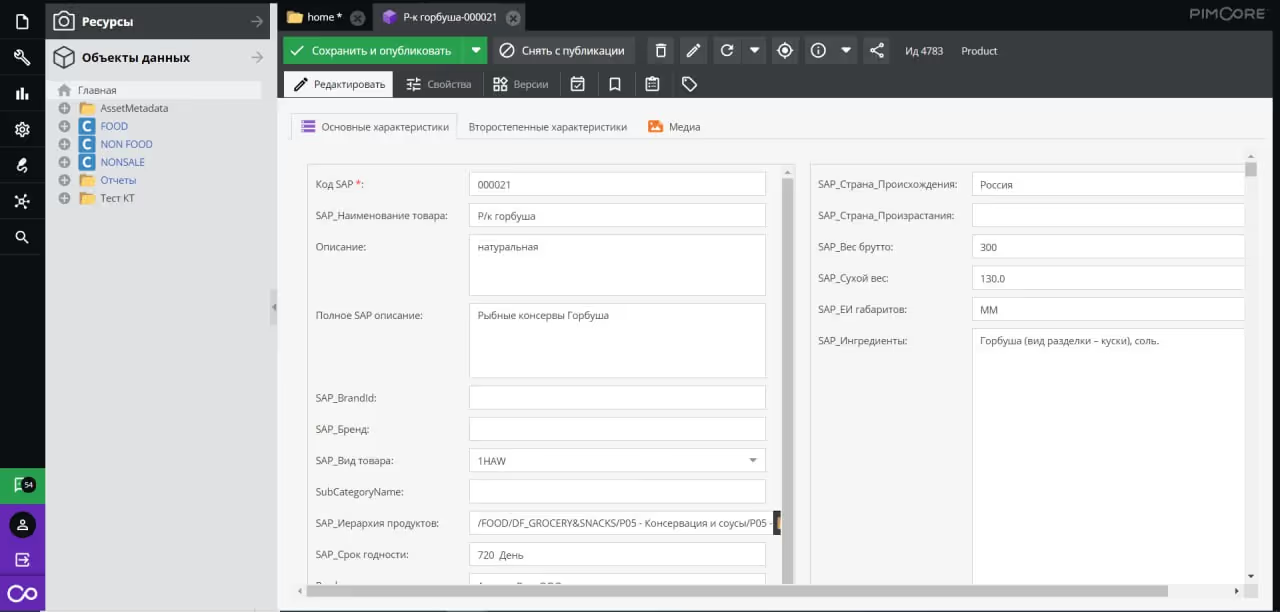When a Russian company plans to introduce a PIM system, most often the choice comes down to two “contenders”: Pimcore and Brandquad. Both systems have the same marketing promises: they will help clean up product data, reduce manual labor, and help increase sales. But...
The real (and often key for a business customer) differences go deeper. Integrators are not always ready to talk about them, and you can't find information about everything on vendor websites either. But it is precisely these differences and features of the systems that will ultimately influence how effective the implementation will be and whether the PIM system will bring the expected results.
Having been implementing PIM systems since 2020, we meet with business representatives every day and answer their questions about the functions and nuances of popular PIM systems. In this article, KT.team experts have collected information about the aspects of PIM that our customers pay attention to. This will help make the choice of the system more transparent and effectively use the budget for implementing PIM and DAM.
Disclaimer: what we look at when analyzing the PIM system
When choosing comparison parameters, we took into account the goals of implementing a PIM system that companies usually set for themselves. Achieving these goals becomes a marker of the effectiveness of investments in PIM.
The PIM system should clean up product data. This means that it should centrally store all existing information about goods, cards should not be duplicated, and information must be complete and accurate.
The PIM system should facilitate increasing sales metrics: number of customers, average check, upselling, repeat sales, etc.
PIM system users should easy to learn its features, don't get confused about buttons and sections.
The PIM system is possible easy to integrate with existing systems. To do this, you don't need to write complex and poorly maintained integrations on a rare stack.
PIM system can be improved taking into account the peculiarities of the company's business processes. For example, one of KT.team's clients uses the PIM system by employees of several directorates and dozens of departments. Someone enters data about new products, someone enriches product cards with media files, someone generates marketing information and makes decisions based on analytics, etc. Each item should have access to its own data pool and only at a specific stage in the product life cycle.
The PIM system should meet safety requirementsthat exist in the company. For some companies, it is important that the core of the system be located on their own servers, while others use SaaS solutions (abbreviated from English software as a service, Russian. “software as a service”) is acceptable.
Based on these parameters, we've made a short plan for reviewing Pimcore and Brandquad:
- a set of features out of the box (what PIM can “close” immediately after implementation, and what the development team will have to add to take into account the specifics of your business processes);
- what additional features that affect sales and marketing can be connected to the system;
- how can a PIM system be integrated with an existing IT circuit — are there any ready-made APIs;
- where you can host the system (in the cloud or on your own servers);
- are improvements possible if the boxed solution is not enough;
- how much does it cost to own a system (licenses, cloud space, additional users, additional features).
Brandquad platform overview
An ecosystem of products for working with product data. Includes PIM, DAM, DSA modules (abbreviated from English digital shelf analytics, Russian. “analytics for digital shelf management”), e-commerce analytics, data distribution.
.gif)
One of the main languages of the Brandquad interface is Russian, and there are instructions and support in Russian. Therefore, Russian-speaking users easily master the platform.
Basic features available out of the box
Brandquad has two boxed plans: PIM and PIM Lite. They have a different set of basic functions.
Brandquad PIM and PIM Lite versions include:
- customizable product cards;
- automatic data validation, assessment of the quality of filling out product cards;
- product category tree;
- bulk data import;
- module for setting up business processes for approving documents (with restrictions);
- a system for monitoring product cards on retailer websites;
- transcription of attributes for broadcasting to English-language sites.
The following services and features are only available in the full Brandquad PIM version:
- DAM tools;
- building product information models;
- links between goods (for example, for additional sales);
- setting up different levels of access to cards and business processes by role;
- unlimited public catalogs (only one in the PIM Lite version);
- transfer of the product catalog to sales channels (only within the functionality of the ready-made API; everything that is not included in the capabilities of this API must be additionally ordered from Brandquad).
Business users note that Brandquad is well equipped to search for products and filter them; Pimcore, which we'll talk about in the next part of this article, has less convenient and accurate features.
On the contrary, custom uploading of reports or product collections by attributes has not been implemented. To get these features, you need to order an appropriate upgrade from the vendor.
Additional Brandquad features that help increase sales and improve marketing processes
Public catalogue — a virtual showcase with a user interface synchronized with PIM. It allows you to show a catalog or a selection of products to any number of customers, as well as transfer product information via API, newsletters or manual export directly from the catalog in CSV, PDF, XLSX, XML formats.
E-commerce analytics module collects information on prices, reviews, and promotions from more than 300 sites, both by company and by competitor.
BuyButton — a widget that can be connected to the site (if it is not an online store) or the company's social networks. A button (or a set of buttons if your product is available on several sites) will allow the buyer to go to the product card on a convenient sales channel.

Plugins for interacting with Adobe Photoshop, Adobe InDesign, Figma — improve the quality of work with media assets and metadata.
Algorithms for distributing data to online platforms — automated algorithms based on machine learning that convert all the necessary content into the format of each retailer or partner: from product names and marketing descriptions to image resolution and file titles.
Accommodation options
Brandquad is distributed only on the SaaS model — the company gets access to its space on Brandquad servers.
Refinement opportunities
Brandquad has a closed code that only the vendor company has access to. Any improvements are possible only through a feature request; an in-house IT team or contractor can only help with setting up basic features. The deadline for the feature request depends on the Brandquad team's backlog and product development plans.
Integration options
The full version of the system provides a ready-made API for integration with 1C, SAP, website, etc. But the attributes and formats that can be passed through this API are limited. To transfer a non-standard set of attributes, you must order an appropriate API update from the vendor.
The cost of licenses
A commercial offer from Brandquad is drawn up individually. The annual amount of payments depends on the version of the system, the resources required, and the number of users. For example, one of KT.team's clients with a catalog of 125,000 items paid 5 million rubles a year.
Which companies is suitable for Brandquad
Companies with a linear product card structure and a small number of dependencies. Companies with a simple product catalog. Companies whose product management processes are already established and change minimally, and whose processes for approving cards and categories are simple and short.
Brandquad is suitable if you need to quickly launch a product or digital asset management system and organize the prompt upload of information to marketplaces and electronic catalogs.
For example, In eight weeks, KT.team implemented Brandquad and set up uploading to 13 sales channels for Campari RUS LLC →.
Pimcore platform overview
A multifunctional platform that has long gone beyond PIM. Pimcore currently includes PIM, MDM, DAM, DXP modules (abbreviated from English digital experience platform, Russian. “a platform for working with the digital experience of customers”), DCF (abbreviated from English digital commerce framework, Russian. “e-commerce framework”). Using one or more of these modules, a company can configure a visual presentation of reliable information not only about the product, but also about related assets, as well as about customers.

Basic features available out of the box
The following features are available in all Pimcore versions (Community Edition PaaS and on-prem, Enterprise Edition, Unlimited Subscription):
- product catalogs of any complexity and with any interdependence;
- building product cards with any logic and information model;
- link to value guides by colors, sizes, materials, etc. ;
- fields with calculated values (using mathematical formulas or composite values);
- communication with media assets;
- validation of cards and data;
- building workflows (business processes) for working with product information — from linear to complex;

- integration with external systems and applications;
- publication on sales channels;
- multilingual support and AI translation of card content;
- relationship between goods (analogues and additional sales).
Only in paid versions of Pimcore:
- PXM (abbreviated from English product experience management, Russian. “product interaction management”);
- PDS (abbreviated from English product data syndication, Russian. “product data dissemination”) is an analytical tool that allows you to increase sales and improve the customer experience through more than 2500 channels;
- CDP (Customer Data Platform);
- building alternative hierarchies and category trees (a useful feature if several departments work with a product at once, each of which has its own catalog and product card logic);
- integration with Adobe and Microsoft products.
Additional Pimcore features that help increase sales and improve marketing processes
Customer Data Platform (only in paid on-premises versions) — collects data on customer activity on various sales channels. It allows you to create a customer portrait, more accurately segment the audience, unify user profiles, and automate some marketing tasks to personalize content.
Digital Commerce Framework (only in on-premises versions) — a framework for building automated omnichannel B2C commerce.
Digital Experience Platform — a headless platform for centralized content management for several sites in different languages and with different target audiences. It takes on a wide range of tasks: from creating and adapting content to analytics and optimizing clients' digital experience.
Accommodation options
Each Pimcore plan offers cloud and on-premise hosting options. However, it should be noted that some features are only implemented in the on-premises versions of Pimcore.
Refinement opportunities
Pimcore is an open source platform written on the Symfony framework. Any IT team familiar with the stack will be able to customize the platform for unique processes and business features. IT integrators who have several Pimcore implementation cases in their portfolio may have ready-made bundles (unique code improvements) for the tasks and features of your company's business processes.
Overall, Pimcore is quite flexible; it includes many microservices and tools for various business tasks.
For example, one of KT.Team's clients, a manufacturer of sanitary ware and bathroom products, had a catalog structure that involved the creation of 300 classes (directories referred to by product cards). This number of classes significantly reduced performance system, so we used one of Pimcore's options — Classification Store. This option allows you to remove classes from the main load and link to them only when necessary, without affecting the performance of the PIM system as a whole. The Classification Store option also allows you to “pack” additional product characteristics and pull them to the card depending on the product category.
Integration options
The Pimcore box has a REST API by default. You can configure its endpoints in Pimcore Datahub to transfer exactly the set of attributes they need to each system and application.
The cost of licenses
Pimcore offers three basic plans to choose from.
- The Community Edition is a free version of Pimcore with a limited number of installs within a single company. It does not support some features, including Product Experience Portal, Asset Experience Portal, integration with Adobe and Microsoft marketplaces and programs, workflow editor, and additional features for uploading product information. There is no user support from Pimcore.
- Enterprise Edition is an extended version of Pimcore, which provides all the platform's features. The cost starts from 1800€ per month, depending on the range of options. Payment is charged annually. A limited number of installations within the company (but not the number of users), technical support is available.
- Unlimited Subscription is the maximum version of Pimcore without restrictions on functionality and the number of installations within one organization. The cost starts from 7200€ per month.
Which companies is suitable for Pimcore
Pimcore does not impose any special restrictions on the size and profile of the company that can use the system, especially considering the almost endless possibilities for refining the system.
Thus, the free Community Edition can be suitable for small businesses and large companies with relatively simple product management processes. Paid (and with more features) versions better meet the needs of large companies with complex processes: they can build multi-stage product information workflows that take into account the involvement of several departments and doses of roles.
What questions to ask so you don't make a mistake when choosing a PIM system
The choice of a PIM system depends on your company's existing processes for working with product information.
Before deciding on a vendor, consider the following nuances.
- What features do you need inside PIM, and what features can you keep on (or include) on other systems? This issue can be addressed together with the contractor, for example, as part of a pre-project survey.
- Are the features out of the box enough for you? Will improvements be needed? Take into account the processes that the company already has.
- What systems should PIM be integrated with? What information will you need to receive and give away?
- What additional marketing and analytics options do you have a request for?
Read more about the seven steps you need to take before implementing a PIM system in our article”Why you can't just adopt and implement a PIM system→”.
Do you need a consultation or pre-project examination? Write to our manager using the form ↓.









